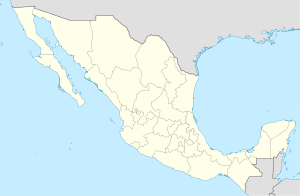San Sebastián Nicananduta facts for kids
Quick facts for kids
San Sebastián Nicananduta
|
|
|---|---|
|
Municipality and town
|
|
| Country | |
| State | Oaxaca |
| Population
(2005)
|
|
| • Total | 1,412 |
| Time zone | UTC-6 (Central Standard Time) |
| • Summer (DST) | UTC-5 (Central Daylight Time) |
San Sebastián Nicananduta is a town and municipality in the south-western part of Oaxaca, Mexico. This area is part of the Teposcolula District, which is in the center of the Mixteca Region.
As of 2005, the municipality had a total population of 1,412 people.
Contents
What Does Nicananduta Mean?
The name Nicananduta comes from the Mixtec language. "Nica" means "calls" or "gushes," and "ndute" means "water." So, Nicananduta means "Place where water gushes."
A Look Back: History of San Sebastián Nicananduta
This town was founded around the year 1700. It grew because there were many springs and fruit trees like apples, peaches, and capulín. There was also plenty of wood.
The town's first name in the 17th century was San Sebastián del Rincón. Later, in 1780, it was called San Sebastián de Almoloya. In 1886, it officially became a municipality named San Sebastián Nicananduta, which it is still called today.
During the Mexican Revolution, this community was a base for the Zapatista Army. Important leaders like C. Jerónimo Orlae, an Agrarista leader, and C. Diódoro Battle, who fought against the government, were here. Diódoro Battle was exiled but taught people to read and write, and the community protected him.
Education in the town was first paid for by families until 1930. After that, federal primary education began. The first federal school was named José María Morelos Pavón, and its first teacher was Josefina Solis.
Important Moments in History
- 1909: There was a conflict with the nearby town of San Antonino Monteverde. To free their captured people, the community had to sell their goats and two church bells to raise money.
- 1980: On January 20, fireworks exploded in a primary school classroom. Some people were badly hurt and sadly passed away later.
- 1984: An explosion happened in the town center early in the morning. It's thought that about 20 boxes of explosives went off. Seven people were injured, including one person from the community.
- 1999: In June, a strong earthquake with a 7.0 Richter scale rating hit the area. Several buildings, including the church and schools, were damaged.
Exploring the Geography
Where is San Sebastián Nicananduta?
The town is located in the western part of the Mixteca Region. It sits high up, about 2,360 meters (7,743 feet) above sea level.
It shares borders with several other towns. To the north is Santa Maria Chilapa de Díaz. To the west are San Antonino Monte Verde, San Juan Ñumí, and San Pedro Yucuxaco. To the south and east is San Pedro and San Pablo Teposcolula. The capital city, Oaxaca, is about 135 kilometers (84 miles) away.
The municipality covers an area of about 45.06 square kilometers (17.4 square miles). This is a very small part of the entire state of Oaxaca.
To the south, there are green, mountainous hills that reach about 3,000 meters (9,842 feet) high. To the northwest, there are rocky hills around 2,500 meters (8,202 feet) high.
Two mountains, Cerro Ticóndo and Cerro El Tambor, surround Nicananduta.
Cerro Ticóndo
The land around Cerro Ticóndo is mostly hilly. The mountain itself is about 2,989 meters (9,806 feet) high. There are not many people living in this area. The closest larger town is San Andrés Dinicuiti, which is about 18.1 kilometers (11.2 miles) north. The area around Cerro Ticóndo is very natural, with lots of open fields.
Cerro El Tambor
The area around Cerro El Tambor also looks like typical countryside. This mountain is about 3,046 meters (9,993 feet) high. Like Cerro Ticóndo, it's not very populated. The nearest town is San Miguel Monteverde, about 13.5 kilometers (8.4 miles) west. The land around Cerro El Tambor is mostly covered with natural fields.
Rivers and Springs
South of the town, there are several springs. These springs feed two rivers that flow towards the center of the town. Another river flows south from the mountains towards the city of Tlaxiaco.
What's the Climate Like?
San Sebastián Nicananduta has three main types of climate. Towards the south, it's cold. In the center, it's temperate (mild). To the north, heading towards Santo Domingo Yodohino, the climate is warm.
Plants and Animals: Flora and Fauna
Nicananduta is home to many different plants and animals.
- Trees: You can find Oaks, Montezuma Pine, Madrona, and Junipers.
- Other Plants: Cactus leaves and Agave Americana grow here.
- Animals: The area has Deer, rabbits, coyotes, foxes, many kinds of birds, armadillos, and squirrels.
Culture and Traditions
Popular Festivities
Every year, the town celebrates a special party for its patron saint, San Sebastián Mártir. This celebration includes a fair held on January 19, 20, and 21.
Traditions and Fun Events
The town enjoys many traditions and social events. These include:
- Jaripeos (cowboy festivals with bull riding)
- Basketball games
- Fireworks displays
- Choosing and crowning the village queen and her princess
- Big dances and other community gatherings
Music
The local music scene features regional band music and "conjunto" music, which is played by small musical groups.
Artisans and Crafts
Women in the community are skilled artisans. They traditionally weave "petates" (mats) and "tenates" (baskets).
Delicious Local Food: Gastronomy
The typical and traditional foods of San Sebastián Nicananduta are very tasty! You can enjoy:
- Tamales
- Mole (a rich sauce)
- Pozole (a hearty soup)
- Regional sauces
- And, of course, the delicious beef broth!


